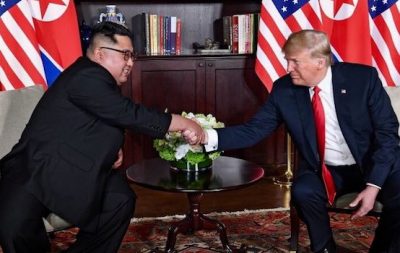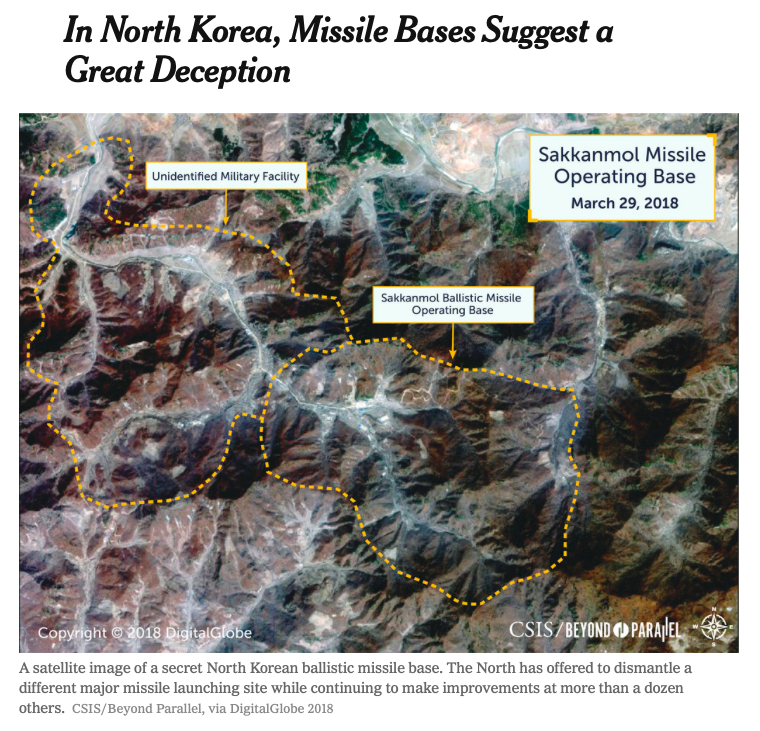North Korea ‘Deception’: US Media, Malpractice or Laziness?
In this latest distortion of 'smoking gun' satellite images, the media continues its attempts to blow up Trump's nuke negotiations.

Major news outlets have resumed efforts to pressure President Donald Trump to pull back from trying to negotiate a deal with Pyongyang. In their latest salvo last week, The New York Times and CNN completely misrepresented the findings of a recent study of satellite photos of a North Korean missile base as evidence of bad faith and “deception” in talks with the United States.
A New York Times article bore the sensational headline, “In North Korea, Missile Bases Suggest a Great Deception.” In a breathless tone, the writers, David E. Sanger and William J. Broad, declared that the satellite images “suggest that North Korea has been engaging in a great deception,” because it had offered to dismantle a major launching site while “continuing to make improvements at more than a dozen others that would bolster launches of conventional and nuclear warheads.”
Screengrab from The NYT
If such improvements had been made during the U.S.-North Korean exchanges, they have might well merit official and public attention—if they have given North Korea new capabilities for threatening the United States or its allies, as Sanger and Broad suggested. But a review of the study of the satellite images of the base reveals that it does not describe any such improvements as claimed by the Times. On the contrary, the study says the satellite images “show minor infrastructure changes to the base that are consistent with what is often seen at remote KPA {Korean People’s Army] bases of all types.”
Furthermore, according to the study issued by Washington’s Center for Strategic and International Studies (CSIS), those same minor infrastructure changes had been observed at a number of similar missile bases, along with training and operational readiness improvements that the authors presume have existed ever since the reorganization of the Strategic Rocket Command into the Strategic Force in 2013.
In short, there were no “improvements that would bolster launches of conventional and nuclear warheads” that could be cited as evidence of an effort by North Korean Chairman Kim Jong Un to deceive Trump. Sanger and Broad either a) did not actually read the study of the satellite images on which they were supposedly basing their accusation or b) were deliberately deceiving their readers.
Further obfuscating the issue, Sanger and Broad argued that the failure of North Korea to “acknowledge” those missile bases “contradicts Mr. Trump’s assertion that his landmark diplomacy is leading to the eliminating of a nuclear and missile program that the North had warned could devastate the United States.” That mysterious formulation seems to imply-–-absurdly—that North Korea had somehow welshed on an obligation to fully inform the United States of its missile assets in advance of a negotiated agreement on the sequence and timing of the steps both sides would need to take to conclude an denuclearization agreement.
Sanger and Broad are well aware that revealing the specific locations of its ballistic missiles to the United States under present circumstances would involve serious military risk for the DPRK. Kim Jong Un cannot reasonably be expected to reveal such information until an a significantly less threatening atmosphere has been established between the United States and North Korea.
And in any case it is completely unrealistic to expect North Korea to end all of its ballistic missile programs. As Vipin Narang of MIT observed to CNN, “Many of these are short-range conventional missiles which North Korea has never said were on the table.” North Korea cannot give them up without losing completely its ability to deter outside attack, since it does not have a modern air force with the necessary capability for deterrence.
CNN’s coverage of the CSIS study made essentially the same false and deceptive claims. “New satellite images cast grave doubt on President Trump’s claim that his negotiations with North Korea are working,” the on air report by Jim Sciutto began. That conflated Trump’s citation of the North Korean cessation of missile testing before any negotiations had begun with any claim about progress on the North Korean missile program in general.
Then came the outright falsehood: “The photos show that Kim Jong Un’s regime is making improvements to more than a dozen hidden missile bases.” Like the Times’ reporters, the network had either failed to read the report at all or had decided to simply lie about what it said. And also like Sanger and Broad, by calling the missile bases “hidden,” it sought to suggest that Kim Jong Il was somehow deceiving the United States by storing them underground.
Buried deep in the Times story is the real reason the newspaper and CNN have both gone to such extreme journalistic lengths to present the CSIS study as new evidence of North Korean “deception.” Victor Cha, one of the authors of the CSIS-sponsored study, commented in an interview with the Times, “What everybody is worried about is that Trump is going to accept a bad deal—they give us a single test site and dismantle a few other things and in return they get a peace agreement.”
The “peace agreement” to which Cha refers would be a declaration by the United States, North Korea and possibly China that the Korean War, which has technically only had an armistice but not formally ended, is indeed over. Kim Jong Un and Trump talked about such a declaration at the Singapore summit, and Trump promised to sign such a peace declaration, according to two sources who knew what transpired between the two men.
The summit meeting’s final statement referred to “establishment of new U.S.–DPRK relations and the building of a lasting and robust peace regime on the Korean Peninsula,” including U.S. security assurances to North Korea.
And last month South Korean foreign minister Kang Kyung-wha suggested that North Korea would be willing to permanently dismantle their nuclear facilities at Yongbyon in return for such a political declaration by the United States.
But as Victor Cha suggested, the Pentagon and the national security elite in general are determined to prevent Trump from entering into such an agreement. The reason for that opposition, as the New York Times itself reported in August, is that it would force the United States to begin “talking about how many American troops are needed in South Korea.” Then it would then have to acknowledge that the U.S. troop presence in South Korea is not only to deter North Korea but “helps the United States maintain a military footprint in Asia and a grand strategy of American hegemony”.
A campaign of bureaucratic resistance to any move toward a peace deal with North Korea is in full swing. And as the latest round of journalist malpractice dramatically illustrates, the corporate media will not hesitate to resort to blatant untruth to support that resistance.
*
Note to readers: please click the share buttons above. Forward this article to your email lists. Crosspost on your blog site, internet forums. etc.
Gareth Porter is an investigative reporter and regular contributor to The American Conservative. He is also the author of Manufactured Crisis: The Untold Story of the Iran Nuclear Scare.
Featured image: President Trump and North Korean President Kim Jong Un shake hands in summit room, June 12, 2018. (Office of the President of the United States/Public Domain)


